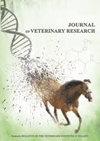2015-2022 年野味动物肌肉中的铯-137 - 含量和时间趋势
IF 1.3
3区 农林科学
Q2 VETERINARY SCIENCES
引用次数: 0
摘要
环境中的放射性铯-137 可能会被植物和动物吸收,并对人类构成营养威胁。生活在森林生态系统中的野生动物是电离辐射环境污染程度的很好的生物指标。可测量到暴露于铯-137 的主要物种是野猪(Sus scrofa)、狍子(Capreolus capreolus)和马鹿(Cervus elaphus)。该研究测定了 2015-2022 年这些野味动物肌肉样本中的 Cs-137 含量。 使用伽马辐射光谱仪检测了 858 份野味动物肌肉组织样本:其中包括 508 份野猪样本、145 份狍子样本和 205 份红鹿样本。 铯 137 的浓度差异很大(从最低检测活性 (MDA) 值到超过 4,000 Bq/kg)。在 63.4% 的情况下,所获得的浓度超过了 MDA 值。有 9 份野猪肌肉样本超过了允许限值(食品为 600 Bq/kg),而在狍子或红鹿肌肉中甚至一次都没有超过。野猪肌肉中的平均浓度是狍子和红鹿的三倍,达到 42.84 Bq/kg。野猪肌肉中 Cs-137 的最高浓度为 4,195 ± 372.0 Bq/kg,狍肌肉中为 111.5 ± 12.50 Bq/kg,马鹿肌肉中为 86.70 ± 3.470 Bq/kg。 七年的数据表明,野猪是野味动物中吸收铯-137 最多的。2015-2022 年间,野味动物肌肉中的铯-137 浓度几乎保持稳定,随着时间的推移,狍子和红鹿肌肉中的铯-137 浓度明显缓慢下降。本文章由计算机程序翻译,如有差异,请以英文原文为准。
Caesium-137 in the muscles of game animals in 2015-2022 – levels and time trend
Radioactive caesium-137 occurring in the environment may be taken up by plants and animals and pose a trophic threat to humans. Game animals living in forest ecosystems are very good bioindicators of the level of environmental contamination by ionising radiation. The main species measurably exposed to caesium-137 are the wild boar (Sus scrofa), the roe deer (Capreolus capreolus), and the red deer (Cervus elaphus). The study determined the levels of Cs-137 in muscle samples of these game animals in 2015–2022.
Using gamma radiation spectrometry, 858 samples of game animal muscle tissue were examined: 508 wild boar, 145 roe deer and 205 red deer samples.
Concentrations of Cs-137 varied widely (from minimum detectable activity (MDA) values to over 4,000 Bq/kg). In 63.4% of cases, the obtained concentrations exceeded the MDA. The permissible limit (600 Bq/kg for food) was exceeded in nine wild boar muscle samples, whereas it was not even exceeded once in roe or red deer muscle. The average concentration in wild boar was three times higher than in roe and red deer and amounted to 42.84 Bq/kg. The highest concentration of Cs-137 in wild boar muscle was 4,195 ± 372.0 Bq/kg, in roe deer muscle it was 111.5 ± 12.50 Bq/kg, and in red deer muscle was 86.70 ± 3.470 Bq/kg.
The seven years’ data indicate that wild boar absorb the most caesium-137 among game animals. The concentrations of Cs-137 in the muscle of game animals in the years 2015-2022 were at a nearly constant level, a very slow diminution being noticeable over time in roe and red deer muscle.
求助全文
通过发布文献求助,成功后即可免费获取论文全文。
去求助
来源期刊

Journal of Veterinary Research
Veterinary-General Veterinary
CiteScore
0.90
自引率
5.60%
发文量
58
审稿时长
18 weeks
期刊介绍:
Journal of Veterinary Research (formerly Bulletin of the Veterinary Institute in Pulawy) is a quarterly that publishes original papers, review articles and short communications on bacteriology, virology, parasitology, immunology, molecular biology, pathology, toxicology, pharmacology, and biochemistry. The main emphasis is, however, on infectious diseases of animals, food safety and public health, and clinical sciences.
 求助内容:
求助内容: 应助结果提醒方式:
应助结果提醒方式:


